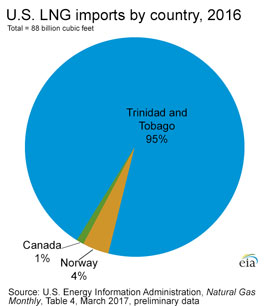What is LNG?
Liquefied natural gas (LNG) is natural gas that has been cooled to a liquid state, at about -260°Fahrenheit, for shipping and storage. The volume of natural gas in its liquid state is about 600 times smaller than its volume in its gaseous state. This process, which was developed in the 19th century, makes it possible to transport natural gas to places pipelines do not reach.
Liquefying natural gas is a way to move natural gas long distances when pipeline transport is not feasible. Markets that are too far away from producing regions to be connected directly to pipelines have access to natural gas because of LNG. In its compact liquid form, natural gas can be shipped in special tankers to terminals in the United States and other countries. At these terminals, the LNG is returned to its gaseous state and transported by pipeline to distribution companies, industrial consumers, and power plants.
The United States imports and exports LNG. Sometimes, LNG originally imported to the United States is re-exported to other destinations where prices are higher. In 2016, the United States imported about 88 billion cubic feet (Bcf) of LNG. All LNG imports were from Trinidad and Tobago (95%), Norway (4%), and Canada (1%).
In 2016, the U.S. exported about 187 Bcf of LNG to 18 countries, which included about 3 Bcf of re-exported LNG. Nearly all LNG exports were by vessel (tanker ships). A small amount was exported by truck to Canada and Mexico.
The top 5 destination countries and shares of total U.S. LNG exports in 2016
- Chile—16%
- Mexico—15%
- India—9%
- Argentina—9%
- China—9%
Interest in using LNG as a fuel for heavy-duty vehicles, ocean tankers, and other transportation applications is on the rise.




